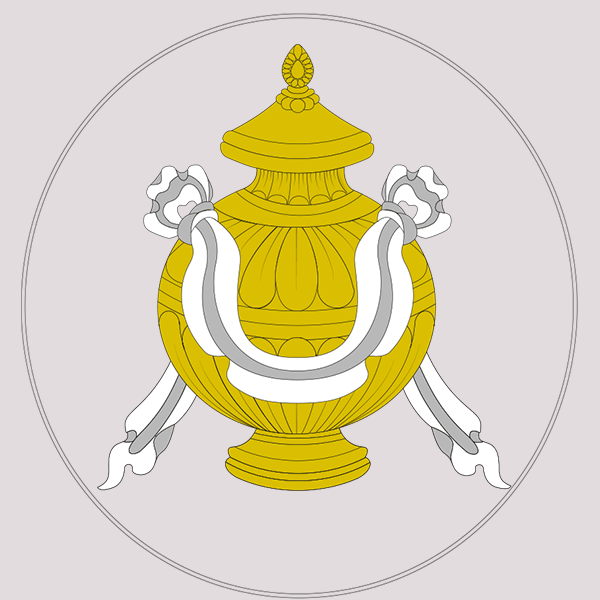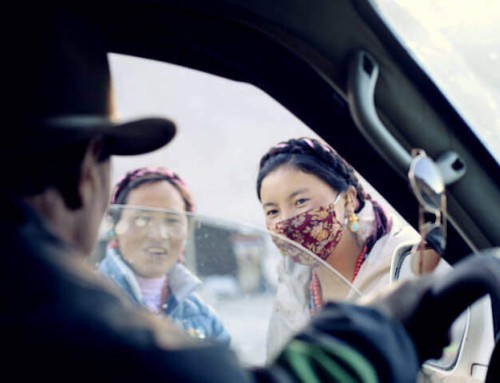Eight Auspicious Symbols of Tibetan Buddhism are the first thing you will see during your Tibet Travel. As you arrive in Tibet, your tour will offer you a Tibetan White scarf called Khata. This scarf is full imprinted with the eight auspicious symbols of Tibetan Buddhism. This set of eight symbols are the most famous symbol in Tibet. In the Tibetan Language, we call it Tashi Tag Gye. In Buddhism, These eight symbols are symbols of good fortune. It is said to be first offered by gods to the Buddha Shakyamuni immediately as he attained enlightenment.
- Brahma, the great god of the form realm, was the first to appear with an offering of a thousand-spoked golden wheel, requesting Shakyamuni to turn the teaching wheel of the dharma.
- The great sky god Indra appeared next, presenting a white, right-spiralling conch shell as a symbol of the proclamation of the dharma.
- The earth goddess Sthavara (Tib. Sayi Lhamo), who had borne witness to the Buddha’s enlightenment, presented Shakyamuni with a golden vase full of the nectar of immortality.
- Iconographically Brahma and Indra are frequently represented to the left and right of Buddha’s enlightenment throne, offering the golden wheel and the white conch shell.

Followings are the Eight Auspicious Symbols of Tibetan Buddhism
1) Right-Coiled White Conch

The right-turning white conch shell represents the beautiful sound of the spread of the Buddhadharma. Its sound is deep, far-reaching and resonant, and hearing it awakens beings from the deep slumber of ignorance, urging them to accomplish their own and others’ welfare. Shells that spiral to the right in a clockwise direction are rare and sacred. The right-spiralling movement of such a conch is believed to echo the celestial motion of the sun, moon, planets, and stars across the heavens. The hair whorls on Buddha’s head spiral to the right, as do his fine body hairs, the long curl between his eyebrows (urna), and also the conch-like swirl of his navel. Today the conch is used in Tibetan Buddhism to call together religious assemblies. It can be used both as a musical instrument and as a container for holy water.
2) Precious Parasol

The parasol is a traditional Indian symbol of both protection and royalty. The ability to protect oneself against inclement weather has always, in all cultures, been a status symbol. It acts as the bearer of the scorching heat of the sun and turns into the spiritual sphere. Thus the coolness of its shade symbolizes protection from the weather of suffering, desire, and other spiritually harmful forces.
The Precious Parasol embodies notions of wealth or royalty, for one had to be rich enough to possess such an item, and further, to have someone carry it. It points to the “royal ease” and power experienced in the Buddhist life of detachment.
The parasol dome is held aloft by a vertical handle, identified with the central axis upholding the world. Its hold above the subject of an important dignitary indicates it as the centre of the universe.
Parasols seem to be especially important in processional rites, being like mobile temples. Thus, depictions of the Buddha often display an elaborate and large parasol above his head. The Precious Parasol symbolizes the beneficial activities of keeping beings from the harms of illness, evil forces, obstacles, and so forth. It also represents the enjoyment of a feast of benefit under its cool shade.
3) Victory Banner

This banner represents the victory of the Buddha’s teachings over death, ignorance, and all the negativities of this world. It also symbolizes the victory of Buddhist Doctrine over all evil and sinister forces.
The roofs of Tibetan monasteries are often decorated with victory banners of different shapes and sizes.
4) Golden Fishes

The two fishes in the eight auspicious symbols originate from the ancient Hindu symbol for two main sacred rivers of India, The Ganges and the Yamuna. For their size and longevity, these two rivers are regarded as beautiful rivers. Moreover, the golden fishes are fearless and happy as they swim freely and spontaneously in oceans without drowning. Thus, the fishes symbolize happiness, for they have complete freedom in the water.
5) Dharma Wheel

The Dharma wheel symbolizes turning the wheel of Dharma (Buddha’s Path). The wheels are initially meant royalty, but Buddhists use them to represent the Buddha preaching the path he found to enlightenment. The wheel has eight spokes refer to the Noble Eightfold path, one of the Buddha’s first teaching. You have most like seen the Dharma wheel on the rooftop of a Tibetan Buddhism Temple and Monasteries. Here the wheel is accompanied by a set of two deer on two sides. Deer are the direct reference to the Buddha’s first teaching in the Deer Park, Sarnath. The legend has it that the appearance of Buddha is so wondrous and so peaceful was his presence that even animals came to listen. In the Our Tibetan tradition, a monastery that holds the two text collections of the Kangyur (direct teachings of the Buddha) and Tengyur (commentaries) would have this symbol of deer on both sides Dharma-wheel on the roof.
6) The Auspicious Endless Knot

The Auspicious or Endless Knot is a geometric diagram that symbolizes the nature of reality. Everything is interrelated and only exists as part of a web of karma and its effect. Having no beginning or end, it also represents the infinite wisdom of the Buddha and the union of compassion and understanding. Also, it means the illusory character of time and long life as it is endless.
7) Lotus Flower

Lotus roots are in the mud, its stem grows through the water, and the scented flowers lie above the water, relishing in the sunlight. This shows the path of a soul from the primaeval mud of three poisons through the sea of practice and discipline into the bright sunshine of enlightenment.
By this, the lotus flower on Eight Auspicious Symbols symbolizes the complete purification of the defilements of the body, speech and mind, and the full blossoming of blissful liberation. During your Tibet tours, you will see that all the deities of Tibetan Buddhism are either holding or sitting on the lotus in the Thangka and statues in altering the monasteries and temples in Tibet.
8) Treasure Vase

The Treasure Vase is known as the vase of inexhaustible treasure, and it symbolizes the infinite riches available in Buddhist teachings. It also symbolizes the endless rain of wealth, prosperity, long life, and all the benefits of this world and liberation. During your Travel to Tibet, you will find the treasure vases in the monasteries alter filled with saffron water. This water is used to purify the offering. We also have a tradition of performing a practice involving storing treasure vases filled with blessing substances to a specific location to generate wealth and harmony.
Conclusion of Eight Auspicious Symbols of Tibetan Buddhism
The Eight Auspicious Symbols are very commonly used in Tibetan Arts and decoration. You will often find in offering in the Potala Palace and every other piece of Tibetan Furniture. We hope this post may have given you a little inside of the Tibetan art form and a little information about Buddhism.

Tenzin Travel is the best Tibetan Travel agency in Tibet. Our agency is one of Tibet’s most experienced tour operators, with over 20 years in the industry. Founded by a local Tibetan family with decades of expertise as guides, managers, and route planners. We craft personalized itineraries for every traveler. Our agency is the highest-rated and most recommended Tibet travel agency on TripAdvisor, Google, and Lonely Planet.
We can make holistic arrangements for your trip to Tibet. Including a Tibet Travel Permit, a Tibetan tour guide, flight tickets, train tickets, vehicle arrangements, and hotel bookings in Tibet.
Our Lhasa office is just steps from Barkhor Square. All our Tibetan team ensures deep cultural, linguistic, and religious insights, setting us apart from other agencies.
Beyond tourism, we support Tibetan communities by donating a portion of each tour to local projects. Your travel to Tibet is about more than profit—it’s about the opportunity for us to give back.















